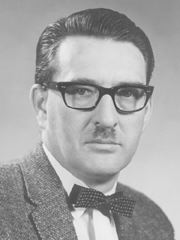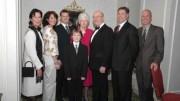Robert William Boyle, a renowned geochemist, author, lecturer, and member of the Canadian Mining Hall of Fame, has died. He was 83.
Boyle was born on a farm near Wallaceburg, a small town in southwestern Ontario, where his family’s land shared a border with that of his future wife, Marguerite. He was fascinated with chemistry at an early age and built a laboratory in the attic. After completing secondary school, he signed up with a mining syndicate and spent two summers prospecting in northern Ontario and Quebec to help pay for his university education.
When the Second World War broke out in 1939, duty called and he joined the Royal Regiment of Canadian Artillery and served for six years with stints in Canada, the U.K. and Europe.
While overseas, Boyle took geology courses at London’s Imperial College, as well as correspondence courses through Queen’s University. Upon his return, he enrolled in mining geology at the University of Toronto and graduated with his bachelors of science degree in 1949. Following some graduate work, he joined the Geological Survey of Canada full-time and completed his doctorate in 1953.
His work with the GSC took him to the Yellowknife gold camp, the lead-zinc-silver deposits of Keno Hill and Galena Hill in Yukon, the Walton barite-sulphide deposits in Nova Scotia, and the sulphide deposits of the Bathurst camp in New Brunswick.
It was during his time in the Yellowknife camp that he developed his “lateral secretionist” theories, which have played a significant role in understanding the formation and interpretation of endogenic halos around some types of mineral deposits.
Boyle’s work at Keno Hill was published in a series of papers. Keno Hill was the first demonstration (outside of the former U.S.S.R.) that proved that geochemistry works in a permafrost environment. The methods he developed at Keno Hill were used to revive a dying mining camp, and operations continued into the 1980s.
In 1955, Boyle persuaded the GSC to set up a laboratory for geochemical prospecting studies. He began a mapping program in the Maritimes, where he carried out the first rapid “heavy metals” regional survey.
In recognition of his pioneering work in geochemical prospecting in Canada, Boyle was elected a Fellow of the Royal Society of Canada in 1957, and in 1971 he received its Willett G. Miller Medal, presented every two years for outstanding research in earth sciences.
Boyle’s work was varied and included a stint at the Cobalt silver camp of Ontario. After stepping down in 1967 as head of geochemistry at the GSC, he redirected his efforts to his first love, precious metals. Thus began a writing career that spawned more than 160 publications. He believed writing should be clear and to the point, and admonished his children, Daniel and Heather, to “write like a Scotsman sending a telegraph.”
Some of his noteworthy texts include The Geochemistry of Silver and its Deposits (1967), Elemental Associations and Indicators of Interest in Geochemical Prospecting (1969), Geochemical Prospecting for Thorium and Uranium Deposits (1982), and Gold: History and Genesis of Deposits (1987).
He retired from the GSC in 1985 and soon found himself travelling throughout the world teaching geochemical prospecting on behalf of the United Nations.
In 1993, he received the Distinguished Service Award from the Prospectors and Developers Association of Canada.
Boyle is survived by Marguerite, Heather, daughter-in-law Christy, and grandson Matthew.





Be the first to comment on "Obituary: Robert William Boyle"